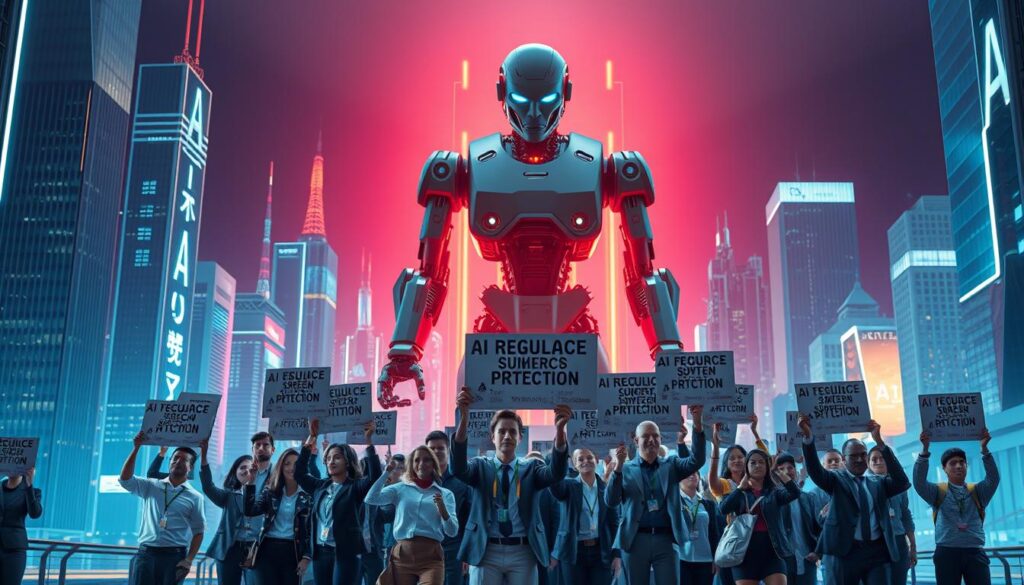Did you know that AI job losses could potentially eliminate up to 50% of entry-level positions in the near future? This startling statistic comes from Dario Amodei, the CEO of Anthropic, who has raised urgent alarms about the looming impact of artificial intelligence on white-collar jobs. While the current unemployment rate in the U.S. stands at a manageable 4.2% as of April 2025, Amodei warns that without adequate preparation, we could soon see unemployment rates soar to between 10-20% within just five years. As advancements in AI accelerate, many workers remain unaware of the automated jobs that could disrupt their livelihoods, highlighting the need for vigilance and regulation in the face of this rapidly evolving landscape.
Key Takeaways
- AI could eliminate up to 50% of entry-level jobs.
- Unemployment rates may rise to 10-20% in five years.
- Dario Amodei emphasizes urgency in preparing for AI disruptions.
- The current U.S. unemployment rate is 4.2% as of April 2025.
- Many workers are unaware of the rapid changes brought by AI.
The Rise of AI and Its Impacts on the Workforce
The integration of AI technologies into various sectors is reshaping the workforce landscape. As businesses increasingly adopt AI, the potential for job displacement rises significantly. This phenomenon prompts a thorough examination of the workforce impact in industries like finance, legal, and technology.
AI technology streamlines processes and enhances efficiency. Consequently, tasks traditionally managed by entry-level workers are now being handled by advanced AI systems. The ramifications extend beyond mere job displacement; they also affect the career trajectories of young professionals who depend on these roles as critical stepping stones.
As job automation accelerates, understanding the implications becomes vital. Individuals must remain aware of the evolving demands of the job market and prepare for an environment where adaptability and continuous learning are essential.

| Sector | Susceptibility to AI | Impacted Job Roles |
|---|---|---|
| Finance | High | Analysts, Accountants |
| Legal | Medium | Paralegals, Researchers |
| Technology | High | Support Staff, Junior Developers |
Understanding the White-Collar Bloodbath: Anthropic Warns of AI Job Losses
The transition towards AI technology marks a significant shift in the labor market, especially for white-collar sectors. Entry-level positions face considerable risks as companies lean towards automation to enhance efficiency. This trend poses a substantial challenge for recent graduates seeking to climb the career ladder.

What Does This Mean for Entry-Level Jobs?
Entry-level jobs serve as the foundation for many young professionals, offering essential experience in various fields. With AI systems capable of performing tasks traditionally assigned to junior staff, the landscape is altering rapidly. Consequently, candidates may find fewer opportunities available in roles such as junior coding and consulting, roles vital for career development.
Potential Unemployment Rates: A Future Projection
The projected job losses in the white-collar sectors raise concerns about rising unemployment rates. Analysts suggest that as automation becomes prevalent, many entry-level jobs could vanish, leading to a challenging job market for new entrants. This situation could create a ripple effect, leaving individuals struggling to secure finance and stability due to a potential lack of opportunities.
The Role of AI Technology in Job Automation
AI technology has reshaped the landscape of job automation, influencing industries in ways previously thought impossible. As these technologies evolve, they transition from supporting human tasks to taking over routine and complex job roles entirely.
Current AI Capabilities: From Coding to Consulting
Today’s AI capabilities extend to various functions including coding, financial analyses, and even consulting. Businesses utilize AI tools to enhance efficiency in multiple areas:
- Cost reductions: Automating repetitive tasks helps cut expenses, allowing money to be allocated to innovation.
- Increased speed: AI processes data and performs tasks at a rate far beyond human abilities.
- Enhanced accuracy: Through advanced algorithms, AI minimizes human error in calculations and analyses.
The Growth of AI Tools and Their Business Applications
The number of AI tools available for business applications is rapidly growing. Many organizations are incorporating AI-driven solutions to streamline operations and enhance productivity. This trend significantly impacts various sectors. A comprehensive overview of some prominent AI applications in businesses can highlight their widespread adoption:
| Business Function | AI Application | Impact |
|---|---|---|
| Customer Service | Chatbots | 24/7 support and efficiency in responding to inquiries. |
| Data Analysis | Predictive Analytics | Optimized decision-making and forecasting. |
| Human Resources | Recruitment Tools | Streamlined hiring processes and enhanced candidate matching. |
| Finance | Automated Reporting | Simplified reporting and real-time financial monitoring. |
As AI technology continues to advance, the implications for job roles are significant. With automated processes becoming standard practice, companies strive for efficiency, often prioritizing AI solutions over human labor. Your professional landscape could vary dramatically as automation becomes more entrenched in business applications.

Industries Most at Risk from AI Disruption
The rapid advancement of AI technologies brings a myriad of changes, particularly affecting certain sectors. As we delve into the industries at risk, it’s vital to recognize how AI disruption poses significant threats, especially to white-collar jobs. Areas like technology, finance, legal, and consulting are experiencing substantial shifts, with many junior roles facing potential removal. These industries must adapt quickly to navigate the challenges and safeguard job security for their workforce.
White-Collar Sectors Facing the Greatest Threats
Among the industries at risk, those involving data processing, analysis, and client interaction are vulnerable. For instance, in the finance sector, algorithm-driven tools can replace roles in auditing and data entry, while legal support functions may be streamlined through AI-assisted document review. In technology firms, junior programmers might find themselves sidelined as AI tools automate coding tasks. The demand for these traditional roles may diminish, raising concerns over job security for many professionals.
Impact on Young Professionals and Recent Graduates
The implications of AI disruption are particularly harsh for young professionals and recent graduates. Many of you rely on entry-level positions in these sectors to launch your careers. As employers turn to AI solutions to enhance efficiency, the availability of these crucial roles may rapidly decline. With numerous industries at risk, this shift could stifle career progression and create uncertainty in the job market, leaving emerging talents searching for new avenues and opportunities.

The Predicted Timeline for Job Losses
The anticipated job loss timeline highlights significant changes in employment patterns across various sectors influenced by AI technology. Short-term predictions indicate that immediate impacts could be felt within one to three years, while a broader long-term outlook extends over five to ten years. This evolving landscape suggests that businesses are quickening the pace of AI integration, which will lead to both swift job displacement and shifts in employee roles.
Short-Term versus Long-Term Outlook
In the short-term outlook, many industries will likely experience a noticeable influx of job losses. This rapid transition may create uncertainty, particularly for workers in high-risk positions susceptible to automation. Conversely, the long-term outlook indicates that while some jobs may disappear, new roles could emerge over time as organizations seek to adapt to this changing environment. Longer-term forecasts consider how the job market will stabilize and shift depending on AI’s continued evolution.
Comparative Analysis of Historical Job Displacements
| Period | Job Losses (in millions) | Industry Affected |
|---|---|---|
| The Great Recession (2007-2009) | 8.8 | Finance, Manufacturing |
| COVID-19 Pandemic (2020) | 22.0 | Hospitality, Retail |
| Projected AI Impact (2023-2033) | 12.5 | White-Collar Jobs |

Anthropic’s Call for AI Regulation and Public Awareness
Dario Amodei emphasizes the critical need for AI regulation alongside raising public awareness about potential job market impacts. As AI technology evolves, potential threats to the workforce increase, urging leaders and policymakers to address these challenges head-on. Understanding these implications is essential for developing supportive measures for workers transitioning in an unpredictable landscape.
The Importance of Proactive Measures
Proactive measures are vital in ensuring the safety and well-being of the workforce. By introducing AI regulation, stakeholders can establish frameworks that protect jobs and foster a healthy job market. Public awareness campaigns can play a significant role in informing employees and employers about AI’s impacts and how they may adapt accordingly.
Suggested Policies for Workforce Transition
Policy recommendations aimed at workforce protection include:
- Investment in retraining programs to help displaced workers develop new skills.
- Implementation of job transition assistance programs that support individuals in finding new employment opportunities.
- Collaboration between technology companies and educational institutions to create relevant curriculum that prepares future workers for an AI-driven economy.
- Establishment of safety nets for workers impacted by job displacement, ensuring they have access to necessary resources during transitions.

The Emotional and Social Consequences of Job Loss
The rise of artificial intelligence and automation introduces significant emotional consequences for individuals facing unemployment. This shift has a deep-rooted job loss impact that not only affects personal lives but also ripples through community dynamics. Understanding these effects is crucial for addressing the broader societal challenges that emerge in the wake of job displacement.
Effects on Mental Health and Community Dynamics
Unemployment can trigger a cascade of mental health challenges, including anxiety and depression. People who lose their jobs often struggle to find a sense of purpose, leading to feelings of isolation and despair. This emotional turmoil can create barriers within communities, disrupting established social ties and support networks.
- Heightened anxiety levels among those experiencing job loss
- Increased rates of depression linked to economic instability
- Diminished social cohesion as communities grapple with widespread unemployment
- Challenges in accessing mental health resources due to financial constraints
The overall job loss impact manifests in ways that challenge community dynamics. As job opportunities dwindle, the economic disparity becomes more pronounced, straining relationships both within families and among neighbors. Communities may face the daunting task of supporting individuals who feel disenfranchised, further complicating their ability to foster a sense of belonging and resilience.

Employer Perspectives: Preparing for a Shift in Workforce Dynamics
In the rapidly evolving landscape of work, employer perspectives play a critical role in navigating new challenges brought on by AI adoption. Many corporate leaders recognize the transformative potential of AI technology to redefine workforce dynamics. With AI tools enhancing productivity and driving efficiency, organizations find themselves at a crossroads, contemplating how to implement these technologies effectively while maintaining a skilled workforce.
Insights from Corporate Leaders on AI Adoption
Corporate leaders emphasize the need for businesses to embrace AI as a fundamental part of their growth strategy. This integration requires a comprehensive understanding of employee roles and the workflows that AI technologies will influence. Leaders advocate for open communication and training initiatives to prepare employees for the changing environment, ensuring they supplement machines rather than compete with them. The focus shifts towards fostering a culture that promotes collaboration between human and AI capabilities.
The Strategic Shift Towards AI Agents
The transition towards AI agents marks a significant strategic pivot for many businesses. Employers are exploring various ways to embed AI within their operations, transforming traditional job descriptions. As departments adjust to workforce dynamics shaped by AI, the emphasis on roles that require emotional intelligence, creativity, and strategic thought heightens. Companies understand that equipping their teams with advanced skills will ensure resilience amid these technological changes, helping to create a more adaptable workforce.

Counterarguments: Can AI Create New Job Opportunities?
The discussion surrounding AI job creation often highlights counterarguments that suggest automation may not solely lead to job losses. Historical trends indicate that technological advancements frequently pave the way for new industries and roles. As many experts point out, the workforce evolution triggered by past innovations, such as the internet and automation technologies, demonstrated an ability to adapt and thrive. This potential for growth raises the question of whether AI will follow suit.
Historical Job Creation as a Response to Automation
As automation has transformed industries, new categories of jobs have emerged. For instance, sectors like software development and digital marketing arose directly from previous technological shifts. Such historical precedents suggest that AI job creation could yield new roles in data analysis, machine learning, and AI maintenance. Companies could invest in talent that manages these technologies, creating a robust demand for skilled individuals capable of adapting to rapid changes.
The Paradox of Labor Shortages Amid Job Displacement
Surprisingly, some labor markets currently face shortages of skilled workers despite ongoing job displacement due to AI. Businesses across various sectors often struggle to find individuals with adequate training to fill new positions created by technological advancements. This paradox highlights the need for upskilling and reskilling initiatives aimed at aligning the workforce with evolving demands. As organizations adapt to AI technologies, proactive workforce strategies may help bridge the gap between available jobs and qualified candidates.

Future Job Roles: Adapting to an AI-Driven Economy
As the AI-driven economy continues to evolve, future job roles will likely transform in unexpected ways. You may find emerging occupations dedicated to overseeing AI systems and enhancing existing tasks through technology. This shift will require the workforce to embrace new skills in various sectors.
Emerging Occupations in AI and Technology
In this landscape, you can expect to see roles such as AI trainers, data ethicists, and automation specialists. These positions will focus on ensuring that AI technologies function ethically and efficiently, aligning with organizational goals. The demand for professionals capable of managing AI tools is rapidly increasing, leading to a call for updated educational frameworks.
How Workers Can Upskill to Remain Relevant
To stay relevant in an evolving job market, it’s essential to adopt effective adaptation strategies. Upskilling through online courses, certifications, and workshops can prepare you for future job roles that revolve around AI. Emphasizing skills like data analysis, machine learning, and digital literacy will enhance your employability, allowing you to thrive in an AI-driven economy.

| Occupation | Main Responsibilities | Skills Required |
|---|---|---|
| AI Trainer | Educating AI systems through data input and oversight | Data management, machine learning |
| Data Ethicist | Ensuring ethical use of AI and data privacy | Ethical analysis, communication skills |
| Automation Specialist | Implementing and managing automated workflows | Problem-solving, technical proficiency |
Conclusion
As we navigate the complexities of the future of work, it’s essential to acknowledge both the risks and opportunities presented by AI impact. The potential for widespread job displacement is alarming, yet it also opens the door to new possibilities and roles. By understanding the landscape ahead, you can better prepare for what lies in store.
The key lies in collaboration between corporate leaders, educators, and policymakers. Together, they must promote proactive measures that not only cushion the effects of job losses but also empower you to adapt to the ever-evolving job market. A shared commitment to fostering resilience will be critical as we embrace the changes brought forth by AI technologies.
In closing, the future of work is not set in stone. While challenges exist, so do prospects for growth and advancements. By staying informed and motivated, you can navigate this changing terrain and position yourself to thrive amid AI transformation.









